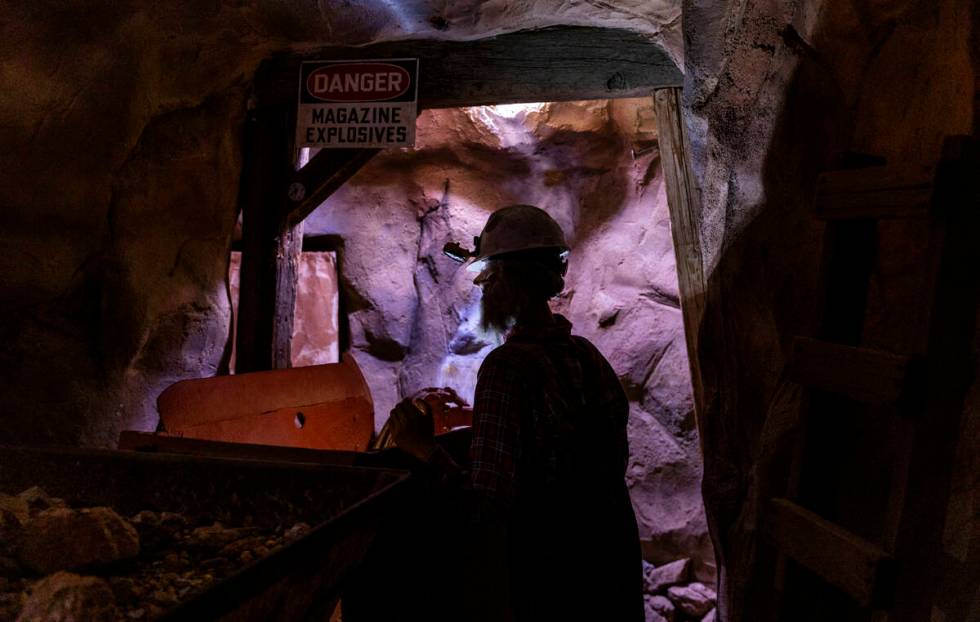Hidden Henderson museum tells the Silver State’s mining story

Inside the mock mining boom town tucked away in downtown Henderson, a worn-down miner animatronic has a message for children who choose to allow him to speak by pressing a red button.
“Some people ask me, why do we need mining?” he says. “There is a saying that if it isn’t grown, it has to be mined. Without mining, the raw materials society relies on for everyday products would not exist.”
The mannequin is a spokesman for an industry that brought nearly $410 million of tax revenue to Nevada in 2023, according to the Nevada Mining Association. He’s a friendly face at The Mine Experience in Henderson, the Las Vegas area’s only museum dedicated to the storied industry that gave Nevada its Silver State nickname.
The Mine Experience, or McCaw School of Mines, opened in 1996 as a local field trip destination owned by the Clark County School District. Because of the rising cost of school travel at the time, the district put out a call to educators and students to come up with new ideas for places it could build itself, said Phil Luna, the museum’s executive director.
A teacher at what is now the McCaw STEAM Academy Elementary School was teaching a unit about mining, and the school’s principal brought the idea to the Clark County School Board, Luna said. It wasn’t until 2019 that volunteers decided to open the museum to the public — only on the first Saturday of every month, because of a lack of volunteers to expand visiting hours.
The exhibit is easy to miss, situated on a side street in Henderson’s slowly growing Water Street District.
“We’re the best kept secret that’s had 150,000 students come through,” Luna said.
Mining roots run deep in Nevada
The crowning feature of the museum is perhaps its simulated, underground mine shaft, designed in a way similar to the Indiana Jones ride at Disneyland. It’s the only one like it in the state.
A handful of exhibits in the dark cave span from mining safety to getting started in a science-based career such as mining.
While much of the state’s mining takes place in rural Nevada, the industry has left its mark on Southern Nevada, as well.
Nelson, a ghost town about 30 miles southeast of Henderson, was a thriving gold district until the 1940s. The same goes for Goodsprings, roughly 40 miles southwest of the museum, which the state estimates produced $25 million worth of primarily lead and zinc.
Henderson itself has a history with mining and manufacturing.
Magnesium desposits from Gabbs, five hours northwest of the city, were processed in Henderson, drawing nearly 15,000 people from across the country to work at the manufacturing plant that opened in 1942. It became the world’s largest producer of the mineral, used in incendiary bombs, munitions casings and airplane parts during World War II, according to UNLV historians.
Though Abraham Lincoln dubbed Nevada the Silver State in 1864 in hopes that silver deposits would help fund the Union’s fight in the Civil War, the state is best known for its bountiful gold deposits.
If Nevada were a country, it would be the fifth-largest gold-producing country in the world, according to the Nevada Mining association. That’s about three-fifths of all of the United States’ gold production.
Eye toward the future
Volunteers like Bill Durbin, the retired Southern Nevada operations head for the Nevada Division of Minerals, also take time on Saturdays and during field trips to show children how to pan for gold and other minerals like obsidian.
The museum is a way for Durbin to continue spreading the knowledge of how important Nevada’s mining industry is.
“It’s to make them think about how we go about mining, how we go about finding a mineral deposit, and the fact that it’s technology that dates back 2,000 years, but we’re still doing it today,” Durbin said of his panning demonstrations. “It’s a really good exploration technique.”
As the mining industry changes, so does the information displayed at the museum. It has up-to-date information about lithium — an in-demand mineral used in electric vehicle batteries.
Nevada is home to the only operating lithium mine in the country in Esmeralda County, and two more are in the process of being constructed: another in Esmeralda County and another in Humboldt County near the Oregon border.
“Looking ahead to the future, Nevada minerals like gold, silver, copper, lithium and silica will be critical in the development of renewable energy and green energy sources like solar panels and lithium batteries,” the visitor’s center animatronic says when prompted.
Luna, the executive director, said more volunteers are always welcome, in hopes that the museum could have more bandwidth to stay open more than one day a week for the public. The museum is open from 9 a.m. to 2 p.m on the first Saturday of the month. For more information about visiting, go to www.mccawmines.org.
Contact Alan Halaly at ahalaly@reviewjournal.com. Follow @AlanHalaly on X and @alanhalaly.bsky.social on Bluesky.